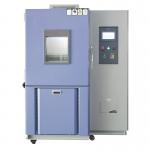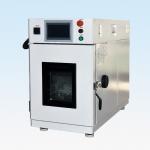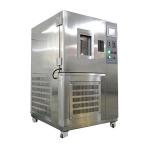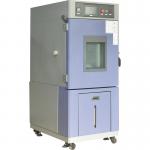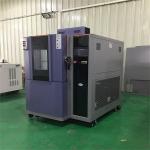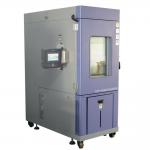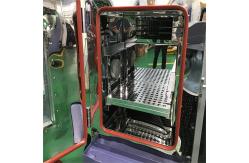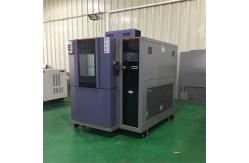In the automotive industry, where innovation and reliability are
the cornerstones of success, the Large Capacity Fast Temperature
Change Climatic Chamber has emerged as a game-changing asset. This
state-of-the-art equipment is designed to meet the specific and
demanding needs of automotive manufacturers and suppliers, ensuring
the durability and performance of vehicle components under extreme
temperature conditions. This climatic chamber, with its generous capacity and rapid
temperature change capabilities, is dedicated to subjecting
automotive parts and systems to a wide range of thermal stress. It
serves as a crucial tool for testing everything from engine
components and braking systems to interior trim and electronic
modules. The primary goal is to replicate the diverse and often
harsh temperature environments that automotive products encounter
during their lifespan, including extreme heat in engine bays, cold
starts in frigid climates, and rapid temperature fluctuations
during driving. By accurately simulating these conditions,
automotive companies can identify potential weaknesses, optimize
designs, and ensure compliance with industry standards and
regulations. - Sturdy and Spacious Design
- The chamber is constructed with a heavy-duty framework, typically
made of high-strength steel, to withstand the rigors of continuous
testing and the weight of large automotive components. The exterior
is designed to be durable and resistant to the chemicals and
abrasion commonly found in automotive workshops and testing
facilities. The interior is lined with a non-reactive and smooth
surface, such as stainless steel or a specialized automotive-grade
polymer, to prevent any interaction between the chamber and the
tested specimens. The large door is engineered for a tight seal,
featuring a reliable locking mechanism and a heavy-duty gasket. It
also includes a viewing window, usually made of tempered glass with
anti-fog and anti-scratch properties, enabling visual monitoring of
the testing process without disturbing the internal temperature
environment.
- Precision Temperature Control Systems
- High-Temperature Zone: The high-temperature system can reach
temperatures up to +180°C or even higher, with an accuracy of
±0.5°C. It utilizes advanced heating elements and a sophisticated
temperature control loop, along with multiple strategically placed
temperature sensors. This ensures rapid and uniform heating of the
samples, essential for effective temperature cycling. The system
also has built-in safety features to prevent overheating and
protect both the samples and the chamber components.
- Low-Temperature Zone: The low-temperature system can achieve
extremely cold temperatures, typically down to -40°C or lower, with
an accuracy of ±0.5°C. It employs advanced refrigeration
technologies, such as cascade refrigeration, and a well-designed
temperature control mechanism. The chamber is equipped with a
powerful circulation system to ensure even cold air distribution.
Similar to the high-temperature system, it has safety features to
avoid overcooling and safeguard the integrity of the testing
environment.
- Temperature Transition: The key feature of this chamber is its
ability to transition between high and low temperatures at a
remarkable rate. The temperature change rate can be as fast as 15°C
to 25°C per minute, allowing for a highly realistic simulation of
the temperature cycling that automotive products experience. The
control panel, which is user-friendly and intuitive, enables users
to program and adjust complex temperature profiles, including the
duration of each temperature stage, the number of cycles, and the
rate of temperature change. It also offers pre-programmed
automotive standard test sequences for quick and easy setup.
- Advanced Instrumentation and Data Acquisition
- The chamber is outfitted with a comprehensive suite of sensors.
Temperature sensors are distributed throughout the chamber to
monitor the temperature at different locations, ensuring that the
samples experience the desired temperature conditions uniformly.
These sensors are connected to a state-of-the-art data acquisition
system that records and stores all the temperature data. The data
can be accessed and analyzed in real-time or retrieved later for
in-depth studies. The data acquisition system is highly flexible
and can be integrated with automotive-specific software and
databases, facilitating seamless data transfer and analysis. It can
also be configured to send notifications and reports automatically,
saving time and effort for the users. Additionally, the control
panel includes built-in alarms and safety features that alert users
in case of any abnormal temperature conditions, power failures, or
equipment malfunctions.
- Volume and Dimensions: With a large capacity, the chamber can accommodate sizable
automotive components or multiple smaller parts simultaneously. The
volume can range from several cubic meters, allowing for the
testing of entire engine assemblies or vehicle interiors. The
external dimensions are configured to fit within automotive
manufacturing and testing facilities, taking into account factors
such as access, ventilation, and clearance. The interior dimensions
are optimized for proper air circulation and temperature
distribution, ensuring that all parts of the tested samples are
exposed to the desired thermal conditions.
- Temperature Uniformity: The temperature uniformity within the chamber is maintained
within ±1°C during both high and low-temperature conditions. This
ensures that all automotive samples experience a similar thermal
environment, which is crucial for obtaining accurate and reliable
test results.
- Temperature Stability: Both the high and low-temperature systems offer excellent
temperature stability, with minimal fluctuations over time. This
allows for consistent and repeatable testing, enabling automotive
manufacturers to compare results accurately and make informed
decisions about product improvements.
- Temperature Change Rate: The chamber can achieve a rapid temperature change rate,
typically ranging from 15°C to 25°C per minute, depending on the
specific settings and the thermal load of the samples. This fast
transition capability is essential for simulating the real-world
scenarios that automotive products face, such as the rapid heating
of engine components during operation and the sudden cooling during
a cold start.
- Accurate Simulation of Automotive Thermal Environments
|
